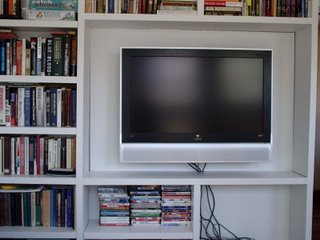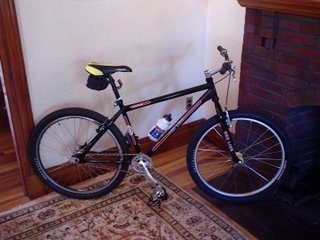
About a year ago, I bought a bare bicycle frame on craigslist. It is a Redline Monocog, a bike that was intended to be a single-speed mountain bike. This particular frame is cool because it is made of steel (some Monocogs are made from aluminum) and because the Redline letters on the frame look like a Boston Red Sox font. I built the frame up with road bike wheels, the rear having a Sachs Duomatic hub. I commuted on this for some of the winter, and it was really cool. But since then it has sat in our basement collecting dust.
A few weeks ago, I woke up in the middle of the night with the idea that it would be very cool to build this bike up as a mountain bike, and in particular as a fixed-gear mountain bike. When I get an idea in the middle of the night, I have to work on it. So I began collecting parts at local used bike stores and on eBay. Here are some of the parts:
Rear Wheel: I had a flip-flop rear road wheel I bought at Simple Living Bicycles in Framingham, Massachusetts. It was a 700c rim with a Suzue hub. Because the rim was too large for a mountain bike, I took the wheel apart by unscrewing all of the spokes nipples and removing the spokes. I bought a new (old) 26" rim at Bikes Not Bombs. It and the hub have 36 holes. I calculated the apprpriate spoke size using Spocalc, bought spokes, and built up the wheel. I use Sheldon Brown's wheelbuilding instructions when I build wheels. I ended up putting on an 18-tooth cog on the fixed side and a 16-tooth freewheel on the other side.
Front wheel: I had a 28-hole BMX hub that I had bought on eBay a few months previous. I bought a 28-hole mountain bike rim on eBay. I had hopes of building it up with a radial spoke pattern, but was a little afraid about breaking the hubs. The concern was mooted when I found that my local bike store only had spoke lengths that would allow me to build the wheel with a 3-cross spoke pattern. So that's what I did.

Cockpit: I had a stem, handlebar, and levers I bought from a kid who does freeride mountain biking. The front lever is an adjustable brake lever that can work with either v-brakes or cantilever brakes, and the rear lever is for cantilever brakes only.
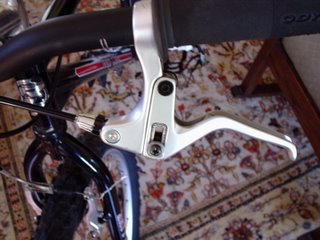
Brakes: I have a box of miscellaneous parts from previous bike projects. I had a set of front v-brakes and rear cantilevers. I attached these to the frame. There was no rear cantilever cables stay on the frame, so I got (at Broadway Bicycle School) the kind that mounts via the seatpost pinch bolt. I cut brake cables and housing to fit using my Dremel cutoff wheel.
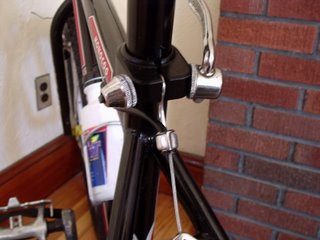
Tires: Craigslist bargain Bontrager Jones XR.
Crankset: Chainring side is a Sugino MTB crank with a 170mm crankarm. I took off the large and small chainrings and left the middle one, which has 34 teeth. I subsequently had to use the granny gear as a spacer to get the chainline right. I was looking for a 32-tooth chainring because I have a 16-tooth rear cog and most people seem to like a 2:1 ratio on fixed gear mountain bikes. But 34 was the best I could do. For the left side, I didn't have a crankarm to match the right side, but I found another 170mm crank in my pile of old parts. They don't match, but they are the same size and work just fine.

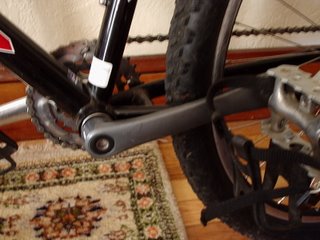
Rear Axle: The Suzue track hub had a solid rear axle, but I wanted to make it quick release so that I could easily flop the wheel over when I want to switch between the the fixed 18-tooth cog and the free 16-tooth freewheel. Track and wanna-be messenger types like to have solid axles because they are strong and because they deter casual bike wheel thieves. But my bike won't be outside unless I am sitting on it. And if you want to flip over the wheel on one of these, you have to carry a wrench with you. So I took a hollow axle from an old rear road wheel, and cut it down to size with the Dremel cutoff wheel. Its bearing cones fit the Suzue bearings. I also cut down a quick release skewer and tapped more threads on it using a 8.5 x 5 metric tap. I had some cheapo chain tensioners that were made for a bike with thicker axles, so I cut them down to fit my axles.
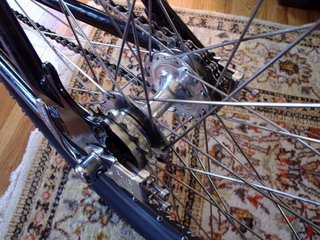


I went out for a ride with my friends on Saturday. They were quite skeptical about the bike and thought that they would be waiting for me a lot. We have a reasonably technical ride route, with some pretty nasty nasty descents, climbs, and lots of undulating terrain with roots and loose rocks. The bike was AWESOME! It was a blast to ride. I kept up with everyone, and found myself right on the tail of the fastest guy a number of times. Because I commute to work every day on a fixed gear, it wasn't too difficult to transition to this on dirt. It is a little odd to have to pedal over jumps and big obstacles. I did feel like I had more control on loose stuff and on steep descents. And on big ascents, I had to think ahead and get up some speed at the bottom of the hill. That's probably the right way to attack ascents, anyway.
All in all, I am very happy about this bike build. It is awesome.
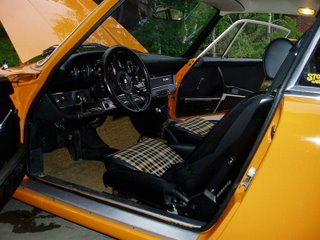
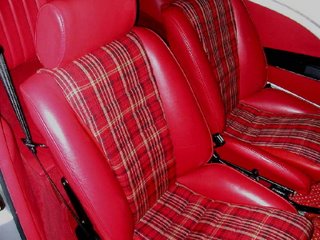
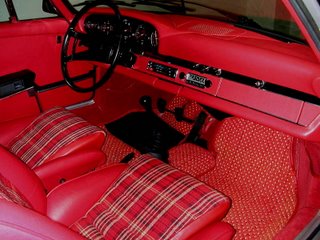
















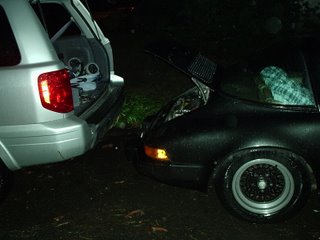



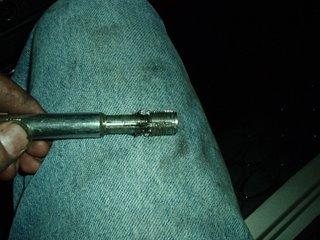





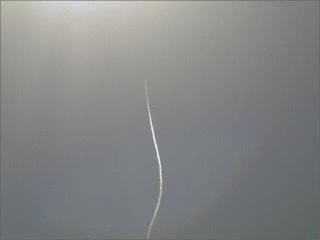

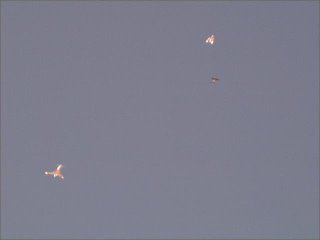







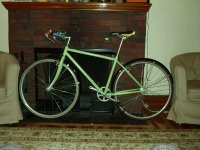


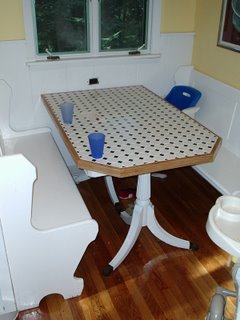

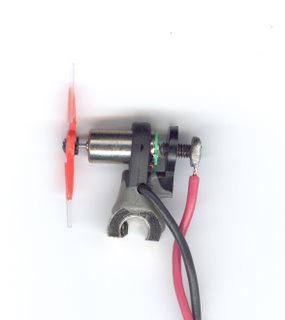
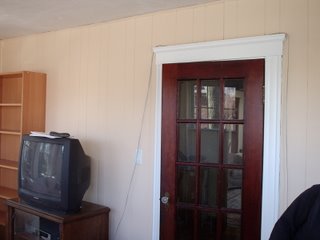
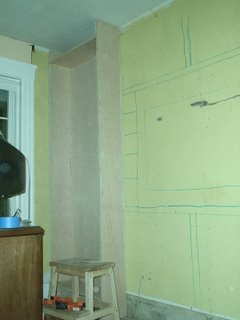 I didn't find any design I really liked until we happend to TiVo an episode of The New Yankee Workshop in which Norm Abrams builds some Georgian bookshelves. I reasoned that those bookshelves could be built and then joined with common crown molding and baseboards. So I copied the plans from watching the show (I ordered the blueprints but they never came).
I didn't find any design I really liked until we happend to TiVo an episode of The New Yankee Workshop in which Norm Abrams builds some Georgian bookshelves. I reasoned that those bookshelves could be built and then joined with common crown molding and baseboards. So I copied the plans from watching the show (I ordered the blueprints but they never came).
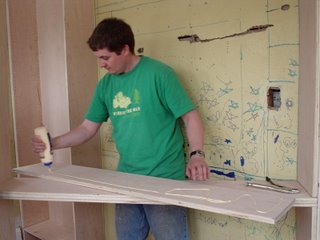 So I built that in the sunroom. The pillars of the bookshelves are 1.5" thick, or two pieces of 3/4" plywood sandwiched together. So where two units met, each of the units was only one piece of plywood thick. The shelves are about 10" deep. I drilled many little holes for shelf pegs using pegboard as a template. The underside of each shelf has four slots dadoed into it to accomodate the pegs and keep the shelves from sliding out. The poplar edging was nailed on using my pneumatic brad nailer, and then the hole was puttied over.
So I built that in the sunroom. The pillars of the bookshelves are 1.5" thick, or two pieces of 3/4" plywood sandwiched together. So where two units met, each of the units was only one piece of plywood thick. The shelves are about 10" deep. I drilled many little holes for shelf pegs using pegboard as a template. The underside of each shelf has four slots dadoed into it to accomodate the pegs and keep the shelves from sliding out. The poplar edging was nailed on using my pneumatic brad nailer, and then the hole was puttied over. We found millwork to match our existing baseboards.
We found millwork to match our existing baseboards. We were tempted to get fancy and put nice millwork on the edges, but the simple look really matches the house.
We were tempted to get fancy and put nice millwork on the edges, but the simple look really matches the house.